page 2
(The Study of Threes)
http://threesology.org
|
Criminal research, amongst other research criteria, often involves a study of the brain. One aspect of the brain is to identify its development such that we find there are 3 divisions labeled: These represent 3 successive (and overlapping) developments. We could also label these divisions as Reptilian ~ Cortex ~ Neo-Cortex, in order to better illustrate that it is the Neo-Cortex which is involved in |
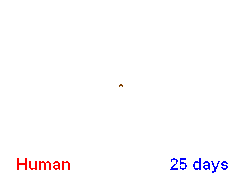 Mammalian Brain
Development Mammalian Brain
Developmenthttp://brainmuseum.org/development/ |
What we term the higher brain functions. It also is recognized that there are three membranes which surround the brain and spinal cord labeled the Pia mater~ Dura mater~ Arachnoid process, even though some researchers prefer to subdivide these three into another set of three, which results in the view that there are six layers, according to some observers. | |
| 3 Major Divisions of the Brain | ||
| Major Division | Subdivision | Structures |
| Prosencephalon (Forebrain) |
Telencephalon | Neocortex; Basal Ganglia; Amygdala; Hippocampus; Lateral Ventricles |
| Diencephalon | Thalamus; Hypothalamus; Epithalamus; Third Ventricle | |
| Mesencephalon (Midbrain) |
Mesencephalon | Tectum; Tegmentum; Cerebral Aqueduct |
| Rhombencephalon (Hindbrain) |
Metencephalon | Cerebellum; Pons; Fourth Ventricle |
| Myelencephalon | Medulla Oblongata; Fourth Ventricle | |
| 3 subdivisions of
the Brain with associated structures. (Roman numerals I- XII refer to the cranial nerves.) | |||||
| External Landmarks | Internal Landmarks | ||||
|---|---|---|---|---|---|
| Major Nuclei | Major Fiber Tracts | Ventricles | |||
| O N E |
|
• Olfactory Nerve (I) |
• Amygdala • Hippocampus • Basal Ganglia - Caudate nucleus - Putamen - Globus Pallidus - Claustrum |
• Corpus Callosum • Anterior Commissure |
• Interventricular Foramen |
|
|
• Optic Nerve (II) • Optic Chiasm • Mammillary bodies |
• Hypothalamus |
• Mammillo-thalamic Tract |
|
|
| T W O |
|
• Inferior Colliculus • Cerebral Peduncles • Oculomotor Nerve (III) • Trochlear Nerve (IV) |
• Central Gray • Red Nucleus |
|
|
| T H R E E |
|
• Cerebellum • Trigeminal Nerve (V) • Abducens Nerve (VI) • Facial Nerve (VII) • Vestibulocochlear Nerve (VIII) |
• Deep Cerebellar Nuclei |
• Mammillo-thalamic Tract |
|
|
|
• Glossopharyngeal Nerve (IX) • Vagus Nerve (X) • Spinal Accessory Nerve (XI) • Hypoglossal Nerve (XII) |
|
• Mammillo-thalamic Tract |
| |
http://faculty.washington.edu/chudler/phylo.html
On another level of research: Three major brain components:
- Chondrocranium, from a cartilagenous precursor, ossified in osteichthyes and later vertebrates
- Splanchnocranium (visceral cranium), gill arches in primitive chordates, anterior two segments converted to upper and lower jaws, posterior segments becoming hyoid apparatus (cartilages)
- Ermatocranium (dermal bones), derived from exoskeleton, covering both chondrocranium and dermatocranium
http://phoenix.liunet.edu/~xwang/Teaching/Bio11/Outline11.htm
3 predominant types of cortex neurons, with respect to brain cells in particular:
- Granule
- Stellate/Martinotti
- Pyramidal
The above three form a three staged construction of:
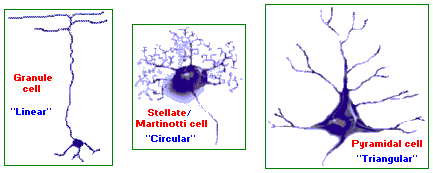 |
Once again, in the foregoing, we can see a three-stage development process from a simple to what we define as a more complex structure.
http://www.andcorporation.com/technology_5b.html
On still another level of research, there customarily are the so-called four recognized brain- wave patterns (that could be viewed as another 3 to 1 ratio for those who are familiar with such thinking):
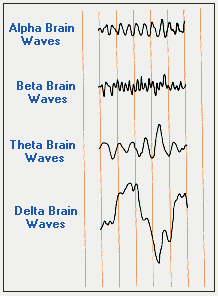
Alpha Waves
Alpha waves are usually present when a person is awake but in a very relaxed and drowsy state, with their eyes closed. These waves are commonly occur before a person falls asleep.Beta Waves
Beta waves occur when a person is awake and alert, such as during problem solving. These waves can also be seen, however, during REM (Rapid Eye Movement) sleep.Theta Waves
Theta waves are more prevalent in children than in adults, but they can occur in adults feeling frustration or with some types of brain disorders. They also are present during light sleep.Delta Waves
Delta waves are present during deep sleep and in people with severe brain disorders.
http://www.macomb.com/~mhs/branwvs2.htm
|
Brought on by unfocusing one's attention, and have relatively large amplitude and moderate frequencies. |
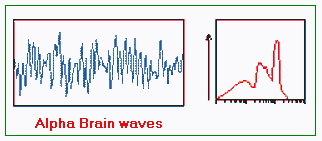 |
|
Result due to heightened mental activity, and typically show rapid oscillations with small amplitudes. |
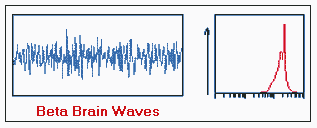 |
|
Accompany feelings of emotional stress, and are characterized by moderately low frequencies. |
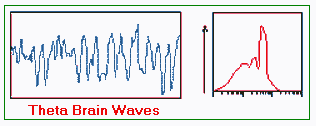 |
|
Result from an extremely low frequency oscillation that occurs during periods of deep sleep. |
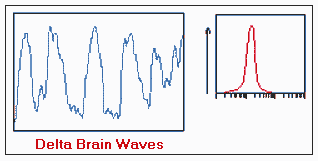 |
|
Resemble croquet wickets in shape, and are associated with physical movements or the intention to move. |
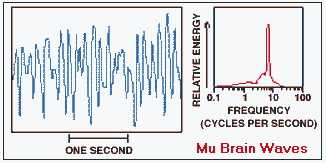 |
Note: the information cited in this example is from the following site of a Featured Article with a link to Brain Waves by:
http://www.sciam.com/1096issue/1096lusted.html
(... Please give Johnny Johnson and the other contributors full credit.)
I wanted to show this alternative view of brain wave research in order to illustrate that there are other brain waves that can be identified with our current level of technology, but there typically are four types that are clearly associated with brain activity when separated from what we might call overt physical or mental activity. In other words, a distinction can be made between brain activity when it is "resting" in the sense of little or no body movement (involuntary twitching notwithstanding), and brain activity when the body is "active," in the sense of brain activity when one is awake. However, if we include the MU brain waves designation, we can have another set of three:
| 1. Alpha - Beta - Theta 2. Delta 3. MU |
These five brain waves can be numerically correlated to the previously mentioned 5 subdivisions of the brain, and the 5-finger/toe (pentadactyl) limb. I make this reference to bring to mind the consideration that while a "5" label is being used, there may in fact be an underlying three-patterned differentiation that can be made. It should also be noted that the 3/5 representation appears in references to DNA with respect to a differentiation of a 3' end and 5' end. (Could this "five" representation be a 3/2 divisioning that can be correlated to the five [3/2] triangles found in starfish (or the human hand/feet) and the 3/2 of right/left brain hemisphere attributes?... Just as the human body shows a 3/2 differentiation of limbs such that the head and two arms are the 3 and the two legs are the 2?) See: --- Harmonic Interference Theory of Richard S. Merrick --- in which he discusses his perspective of "three" and "five" structures. |
Hence, (by excluding the MU brain wave example because of its alternative distinctiveness) we find there are 3 "active" brain waves:
and 1 "resting" (deep sleep) brain wave activity:
In other words, it is a 3 to 1 ratio. It is the same pattern we can find elsewhere:
*** Since the fertile life of the human egg cell lasts at most one day and that of the human sperm at most two days, there is a period of about three days during which copulation can result in conception (the day when the egg is fertile and the two preceding days).
*** Generally speaking, the egg traverses the fallopian tube in about 3 days; Sperm can travel at a rate of 3 inches per hour;
A spermagonium gives rise to 3 active cells and 1 resting cell.
When we look at RNA and DNA, we can see 3 "active" amino acids in the sense that they are mobile by occurring with both RNA & DNA, and 1 "resting" amino acid in the sense that they remain solely with RNA or DNA:
3 "active" {Adenine ~ Cytosine ~ Guanine} to 1 "resting" {Uracil} = RNA
3 "active" {Adenine ~ Cytosine ~ Guanine} to 1 "resting" {Thymine} = DNA
But even if you would prefer to say the obverse that there are 3 "resting" amino acids and 1 "active" amino acid, there would none-the-less be a 3-to-1 ratio.
For additional 3 to 1 ratio examples:
http://www.threesology.org/321-a.php
3-part sleep pattern that is said to have been found in every warm-blooded creature on earth: Deep sleep ~ Light sleep ~ REM (Rapid Eye Movement associated with dreaming.)
3, 4, or 5 Cycles per night (though I have also read 4, 5, or 6 cycles), all of which last approximately 90 minutes in length (before repeating), is the frequency in which the stages of sleep are said to occur.(90 minutes is the typical length of a motion picture). If we include the waking/consciousness state as a stage, we have six stages.
With a five-stage reference, we have:
- Stages 1, 2, 3 as a group.
- Stages 4, 3, 2 as a group.
- REM (Rapid Eye Movement as lull point which signals the repeat of the stages sequence.
(After REM, the sequence repeats: 1- 2- 3- 4- 3- 2- REM 1- 2- 3- 4- 3- 2-...etc... This simple counting sequence reminds me of the history of number usage by primitive peoples. If we add the waking/consciousness state, we have a 3 to 1 ratio configuration. It also brings me to the consideration of whether human society repeats a similar sequence, which would explain the repetition of war, of idiot politicians, inadequate social measures to effectively address the recurrences of poverty, criminal behavior, medical maladies, etc... Correlatively, I wonder if this sequence refers to the accelerated rate of the Earth's rotation. See: --- Earth's rotation rate page 1 ---
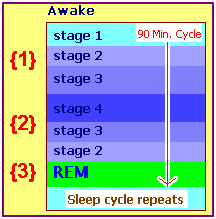
I am using colors to denote the different stages of sleep, with the darkest color representing "Deep" sleep as an analogy to the darkest color representing the deep part of an ocean as might be seen in an illustration that shows the different water depths by using differing colors...the lighter colors indicating shallower depths and the darker colors progressively showing deeper depths. What comes to mind when I view this is that the colors are representing some sort of colorized musical score. I also visualize this portrayal of sleep stages as a metaphorical representation of developmental biology in the early ocean so many billions of years ago. Life may very well had a fluctuating series of developmental stages at different depths of the ocean.
It is interesting to wonder whether our sleep cycle is a nightly recreation of our primordial development, just as our embryonic state is said to re-experience the development that the biological process of so many animals have passed through and yet come to diverge from the human blueprint in later developmental stages. (It is typically called "Ontogeny recapitulates Phylogeny," but has been re-phrased to reflect our present day understanding of early developmental processes: "Embryogenetic Ontogeny recapitulates Embryogentic Phylogeny." For those who are unfamiliar with the concept, it is a theory formulated by Earnest M. Haeckel which states that individuals in their embryonic development pass through stages similar in general structural plan to the stages their species passed through in its evolution. In other words, the (embryonic) development of an individual (Ontogeny) is an abbreviated time-accelerated motion picture which shows the (embryonic) development of an individual species such as all vertebrates.
But not only does the sleep stage sequence remind me of the history of number usage of primitive peoples, it also reminds me of (overall 90 minute) sequences found in other areas. Here are a handful of correlations:
| 3 to 1 ratio:
(Called the four stroke engine. A four cylinder engine based on a 360 degree rotation is divided into 4 90 degree sections, while a six cylinder is 60 degrees and an eight cylinder is 45 degrees. The American standard firing order for a four cylinder water-cooled engine is 1-3-4-2, while the air-cooled Volkswagen, for instance, uses a 1-4-3-2. A 1-2-3-4 firing order would shake, rattle, and roll the engine and possibly tear it from its mounts.) The Hindu Yuga cycle is most definitely based upon the tetractys with a root number of 432 which is the tetractys ratio in reverse order, with the number 1 or unity dropped, viz: 1-2-3-4 reversed to 4-3-2-(1 dropped). Thus, the numbers of years in a Kali Yuga is 432,000 years and each successive Yuga adds to the ten-foldness of the Maha Yuga of 4,320,000 years. This sacred number 432 of the tetractys saturates ancient Hindu, Babylonian, Chaldean and Egyptian cosmological systems. For example, according to Berossus, the reign of the ten antediluvian kings in the Babylonian Marduck mythology was 432,000 years and this was called their "great year". In the Hindu RG VEDA, (the oldest written text) the 10,800 stanzas average forty syllables per stanza for a total of 432,000. In the geometry of Ptolemy, the diameter of his great circles is 432,000 and in his musical theory 432,000 is the least common denominator of his monochord fractions. http://www.vermontel.com/~vtsophia/SYM102a.htm |
| 3 to 1 ratio:
(Called the four seasons, with each season occurring approximately 90 days apart.) |
| 3 to 1 ratio:
(Called the 4, or 5, or 6 stages of sleep that occur every 90 minutes.) |
| 3 to 1 ratio:
(Called the four bases of the triplet genetics code. Is there an as yet unidentified 90-type of reference to the code?) |
| 3 to 1 ratio:
(Called the four intervals in music. [90...?]) |
| 3 to 1 ratio:
(Called the four blood types in the ABO blood typing scheme. [90...?]) |
| 3 to 1 ratio:
(Called the four parts/functions, hierarchal stages of the brain. [90...?] |
| 3 to 1 ratio:
(Called the four types of teeth. [90...?] |
| 3 to 1 ratio:
(Called the four parts of a News program that may occur in One 30- minute segment, Two 30- minute segments, or Many 30 minute segments during a national disaster.) |
Take a look at the following and compare the steps in this cycle with the cyclical pattern of sleep:
Determination of Mating Type by PCR (Polymerase Chain Reaction):
| Sleep cycle: | PCR cycle: | ||
| stage 1 | step 1 | 94°C | 4 min |
| stage 2 | step 2 | 94°C | 30 sec |
| stage 3 | step 3 | 52°C | 30 sec |
| stage 4 | step 4 | 72°C | 2 min |
| stages 4- 3- 2 | repeat step 2 to step 4 for 30 cycles | ||
| REM stage | step 5 | 72°C | 5 min |
http://www.bio.uva.nl/pombe/handbook/section1/section1-3.html
The Polymerase Chain Reaction (PCR) is a powerful technique, which results in the rapid production of multiple copies of a target DNA sequence. The PCR technique has made it possible to analyze DNA fragments in samples that contain amounts of DNA that are either too small, or too degraded, to permit other types of nucleic acid analysis. As a result, it now becomes possible to analyze and characterize DNA fragments found in minute quantities in places like a drop of blood at a crime scene or a cell from an extinct dinosaur. The PCR method is a cycling reaction in which template DNA is denatured by heating to separate the strands of the molecule. Primer (20-30 base fragment of DNA complementary to a region of the template) is annealed to the single-stranded templates. The cycle ends as the primer molecules are elongated by the action of DNA polymerase to produce molecules that are identical copies of the original template. Because the products of one PCR cycle can act as templates for the next PCR cycle, the number of new identical molecules produce doubles with each repetition of the cycle. http://www.accessexcellence.org/AB/BC/PCR_From_Simple_Ideas.html |
The following link may be of interest to some readers:
http://www.haverford.edu/psych/biopsych217b/Neurotheology/pattern.html
Herb O. Buckland
herbobuckland@hotmail.com